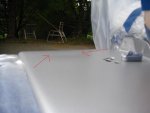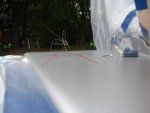FattyMatty
New member
Hey guys -
I bought an '03 Wrangler and found out the one panel is all rusted out. So I cut out the cancer and used fiberglass to fill where the old sheet metal used to be.
I used bondo, glazing putting, and sprayed primer. I was having a REALLY hard time finding highs and lows. I got it as good as I could and figured the base color would fill in the slight "dip" I saw in the repair.
Attached are the pics. I know it's a little hard to see but there is a dip in the paint. It's causing the area that was repaired to look a little brighter than the surrounding paint.
Outside of redoing everything, is there any way to repair this? If I keep adding coats of color could it fill in? (I already put on 10 really light coats and it doesn't seem to be getting better). Is it possible that the clear could fill it in and hide the blemish?
Help! I'm a newb. THANK YOU!
I bought an '03 Wrangler and found out the one panel is all rusted out. So I cut out the cancer and used fiberglass to fill where the old sheet metal used to be.
I used bondo, glazing putting, and sprayed primer. I was having a REALLY hard time finding highs and lows. I got it as good as I could and figured the base color would fill in the slight "dip" I saw in the repair.
Attached are the pics. I know it's a little hard to see but there is a dip in the paint. It's causing the area that was repaired to look a little brighter than the surrounding paint.
Outside of redoing everything, is there any way to repair this? If I keep adding coats of color could it fill in? (I already put on 10 really light coats and it doesn't seem to be getting better). Is it possible that the clear could fill it in and hide the blemish?
Help! I'm a newb. THANK YOU!


